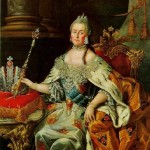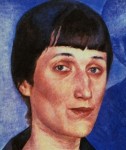 The Fountain House was built by the Sheremetevs in 1712 on a plot of marshland given to them by Peter I. The original Fountain House was constructed of just wood, and resembled a dacha. However, in the 1740’s, Petr Sheremetev decided to expand and embellish the home, transforming it into a palace.
The Fountain House was built by the Sheremetevs in 1712 on a plot of marshland given to them by Peter I. The original Fountain House was constructed of just wood, and resembled a dacha. However, in the 1740’s, Petr Sheremetev decided to expand and embellish the home, transforming it into a palace.
Category: 2009

The Hermitage (Государственный Эрмитаж) is one of the oldest and largest museums in the world. The origins of the Hermitage can be traced back to the private art collection of Tsar Peter the Great, who purchased a large variety of works during his travels to Europe. Founded in 1764 by Tsarina Catherine the Great, it has been open to the public since 1852.
 The Smolny grounds lie on the far eastern side of the city, within the crook of the Neva. They comprise two sites of interest, the Smolny Institute and the Smolny Convent.
The Smolny grounds lie on the far eastern side of the city, within the crook of the Neva. They comprise two sites of interest, the Smolny Institute and the Smolny Convent.
Smolny Institute
Though built in 1806 as a school for wealthy young women, Smolny was not well-known until the Bolsheviks commandeered it in 1917 to headquarter the regional government. Indeed, for a time it served as the personal headquarters of Lenin himself! It also witnessed Kirov’s assassination by Nikolaev and the latter’s subsequent execution (which event sparked the Great Purge 1934-38). The regional communist government operated from the Institute until the fall of communism.
Architecturally, the institute is one of the best examples (along with the Kazan and St. Isaac’s Cathedrals) of the 18th-century Neoclassical movement. Designed by Giacomo Quarenghi, the greatest Russian architect of the period, the strong pillars and triangular crown evoke the temples of Greece and Rome, lending the building power and stature.
Currently, the building serves as the local Governor’s office. It is not open to the general public.
Smolny Convent
 Far more interesting than the Institute, the Smolny Convent boasts one of the most beautiful cathedrals in Russia. Commissioned to house Elizabeth the nun, the convent became a favorite project of Elizabeth the Empress. The original design (by the famed Italian Francesco Rastrelli) called for an even larger complex, including a 140-metre high bell tower. Fortunately, Elizabeth died, leaving the compound unfinished but the imperial treasury in the black.
Far more interesting than the Institute, the Smolny Convent boasts one of the most beautiful cathedrals in Russia. Commissioned to house Elizabeth the nun, the convent became a favorite project of Elizabeth the Empress. The original design (by the famed Italian Francesco Rastrelli) called for an even larger complex, including a 140-metre high bell tower. Fortunately, Elizabeth died, leaving the compound unfinished but the imperial treasury in the black.
Unlike the Institute, Smolny Convent is in the Russian baroque, characterized by “austere lines with richness of decoration and use of colour” (Ioffe 26)—hence the iceberg blue walls, gilt onion domes, and rich ornament. Four domed buildings complement the central cathedral. The entire complex is perfectly symmetrical and in the same baroque style (excepting the interiors).
Our guidebook recommends avoiding wasting money to see the interior, which is “disappointingly severe and suffered from neglect in the Soviet era” (Richardson 201) and, oddly, in the neoclassical style. Though it continues to hold religious services, the Convent now functions primarily as a concert venue.
Works Cited
Richardson, Dan. The Rough Guide to St. Petersburg. Rough Guides 2008.
Question for discussion:
Why would Lenin choose the Institute building for his headquarters during the October Revolution? Do you think architectural symbolism played a role in his choice, or was it more the result of pragmatic availability?
By Yevgeniya Derevyannykh, Richard Jordan, Barry O’Keefe
 She was known as Catherine II during her reign over Russia from June 28th, 1762- November, 17th 1796. Catherine took power after a conspiracy deposed her husband, Peter III (1728–1762), and her reign saw the high point in the influence of the Russian nobility. Under her direct auspices the Russian Empire expanded, improved its administration, and continued to westernize. Catherine’s rule re-vitalized Russia, which grew ever stronger and became recognized as one of the great powers of Europe. During her reign Catherine extended the borders of the Russian Empire southward and westward to absorb New Russia, Crimea, Right-Bank Ukraine, Belarus, Lithuania, and Courland at the expense, mainly, of two powers – the Ottoman Empire and the Polish–Lithuanian Commonwealth. Her successes in complex foreign policy and her sometimes brutal reprisals in the wake of rebellion (most notably Pugachev’s Rebellion) complemented her hectic private life. She frequently occasioned scandal — given her propensity for relationships which often resulted in gossip flourishing within more than one European court. Catherine, throughout her long reign, took many lovers, often elevating them to high positions for as long as they held her interest, and then pensioning them off with large estates and gifts of serfs.
She was known as Catherine II during her reign over Russia from June 28th, 1762- November, 17th 1796. Catherine took power after a conspiracy deposed her husband, Peter III (1728–1762), and her reign saw the high point in the influence of the Russian nobility. Under her direct auspices the Russian Empire expanded, improved its administration, and continued to westernize. Catherine’s rule re-vitalized Russia, which grew ever stronger and became recognized as one of the great powers of Europe. During her reign Catherine extended the borders of the Russian Empire southward and westward to absorb New Russia, Crimea, Right-Bank Ukraine, Belarus, Lithuania, and Courland at the expense, mainly, of two powers – the Ottoman Empire and the Polish–Lithuanian Commonwealth. Her successes in complex foreign policy and her sometimes brutal reprisals in the wake of rebellion (most notably Pugachev’s Rebellion) complemented her hectic private life. She frequently occasioned scandal — given her propensity for relationships which often resulted in gossip flourishing within more than one European court. Catherine, throughout her long reign, took many lovers, often elevating them to high positions for as long as they held her interest, and then pensioning them off with large estates and gifts of serfs.
Questions for discussion in class:
Why did Catherine confer on the nobility the Charter to the Nobility, increasing further the power of the landed oligarchs?
Why do you think Catherine constantly created projects that would legitimate her status as the empress?
By Lindsay Rubio and JP Verheul
 Praskovya Sheremeteva was the subject of a famous portrait painted by Nikolai Argunov, the serf-turned-painter who was the first Russian artist of serf origin to be elected to the Imperial Academy of the Arts. Born a serf around 1770, she caught the eye of her owner, Count Nikolai Petrovich Sheremetev, at the age of 16.
Praskovya Sheremeteva was the subject of a famous portrait painted by Nikolai Argunov, the serf-turned-painter who was the first Russian artist of serf origin to be elected to the Imperial Academy of the Arts. Born a serf around 1770, she caught the eye of her owner, Count Nikolai Petrovich Sheremetev, at the age of 16.
 Vasily Kandinsky started his rise to fame as an abstract painter with the “Jack of Diamonds” exhibition sponsored by Nikolai Riabushinsky, a vigorous patron of young brilliant artists. Kandinsky was part of the group of artists, who “declared a war on the realist tradition and shocked the public with their art” (Figes, 212).
Vasily Kandinsky started his rise to fame as an abstract painter with the “Jack of Diamonds” exhibition sponsored by Nikolai Riabushinsky, a vigorous patron of young brilliant artists. Kandinsky was part of the group of artists, who “declared a war on the realist tradition and shocked the public with their art” (Figes, 212).
 The founding of Peter and Paul Fortress on May 27, 1703 also commemorates the founding of St. Petersburg. Despite the unfavorable marsh conditions, it took only four months for 20,000 conscripts to build the fortress. Originally built with wood, it was later redone in stone under the influence of Domenico Trezzini.
The founding of Peter and Paul Fortress on May 27, 1703 also commemorates the founding of St. Petersburg. Despite the unfavorable marsh conditions, it took only four months for 20,000 conscripts to build the fortress. Originally built with wood, it was later redone in stone under the influence of Domenico Trezzini.



